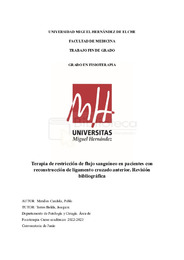Por favor, use este identificador para citar o enlazar este ítem:
https://hdl.handle.net/11000/30341Registro completo de metadatos
| Campo DC | Valor | Lengua/Idioma |
|---|---|---|
| dc.contributor.advisor | Torres Belda, Joaquim | - |
| dc.contributor.author | Miralles Candela, Pablo | - |
| dc.contributor.other | Departamentos de la UMH::Patología y Cirugía | es_ES |
| dc.date.accessioned | 2023-12-12T09:38:11Z | - |
| dc.date.available | 2023-12-12T09:38:11Z | - |
| dc.date.created | 2023-06-16 | - |
| dc.identifier.uri | https://hdl.handle.net/11000/30341 | - |
| dc.description.abstract | Introducción: Las lesiones de ligamento cruzado anterior son muy frecuentes en deportistas, tras la reconstrucción de este aparecen déficits de fuerza y masa muscular de miembro inferior y la rehabilitación convencional no resulta eficaz. La terapia de restricción de flujo sanguíneo (BFR) ofrece una alternativa para los problemas de fuerza, atrofia y dolor articular después de la intervención. Objetivo: Conocer la eficacia del entrenamiento con restricción de flujo sanguíneo en pacientes con reconstrucción de ligamento cruzado anterior. Métodos: Se ha realizado una revisión bibliográfica en las bases de datos de Pubmed, Cochrane, Scopus, Web of Science (WOS) y PEDro para tratar de revisar la evidencia científica sobre la restricción de flujo sanguíneo en pacientes con reconstrucción del ligamento cruzado anterior. Se han utilizado operadores booleanos AND y OR en la cadena de búsqueda. Resultados: Se revisaron 9 artículos, en 5 de ellos se valoró la fuerza (medida con un dinamómetro) y el volumen muscular (medido con ecografía y prueba de imagen) y también en 5 artículos se valoró el dolor (medido con la escala KOOS, la escala de Borg y la escala EVA) Conclusión: El entrenamiento de resistencia con BFR con presión individualizada y cargas bajas que sean superiores al 10% de 1 repetición máxima (RM) mejoran la fuerza y la hipertrofia y reducen el dolor articular. | es_ES |
| dc.description.abstract | Introduction: Anterior cruciate ligament injuries are very common in athletes, after its reconstruction, strength and muscle mass deficits appear in the lower limb and conventional rehabilitation is not effective. Blood flow restriction therapy offers an alternative to improve strength, hypertrophy and reduce joint pain. Objectives: Know the efficacy of training with blood flow restriction in patients with anterior cruciate ligament reconstruction. Methods: A bibliographic review has been carried out in the Pubmed, Cochrane, Scopus, Web of Science (WOS) and PEDro databases to try to review the scientific evidence on blood flow restriction in patients with anterior cruciate ligament reconstruction. Boolean AND and OR operators have been used in the search string. Results: 9 articles were reviewed, in 5 of them strength (measured with a dynamometer) and muscle volume (measured with ultrasound and imaging tests) were assessed, and pain was also assessed in 5 articles (measured with the KOOS scale, the de Borg and the EVA scale). Conclusion: BFR resistance training with individualized pressure and low loads greater than 10% of 1 repetition maximum (RM) improves strength and hypertrophy and reduces joint pain. | es_ES |
| dc.format | application/pdf | es_ES |
| dc.format.extent | 29 | es_ES |
| dc.language.iso | spa | es_ES |
| dc.publisher | Universidad Miguel Hernández de Elche | es_ES |
| dc.rights | info:eu-repo/semantics/openAccess | es_ES |
| dc.rights.uri | http://creativecommons.org/licenses/by-nc-nd/4.0/ | * |
| dc.subject | terapia de restricción de flujo sanguíneo | es_ES |
| dc.subject | restricción de flujo sanguíneo | es_ES |
| dc.subject | reconstrucción de ligamento cruzado anterior | es_ES |
| dc.subject | reconstrucción de LCA | es_ES |
| dc.subject.other | CDU::6 - Ciencias aplicadas | es_ES |
| dc.title | Terapia de restricción de flujo sanguíneo en pacientes con reconstrucción de ligamento cruzado anterior. Revisión bibliográfica | es_ES |
| dc.type | info:eu-repo/semantics/bachelorThesis | es_ES |

Ver/Abrir:
TFG Pablo Miralles Candela.pdf
1,65 MB
Adobe PDF
Compartir:
 La licencia se describe como: Atribución-NonComercial-NoDerivada 4.0 Internacional.
La licencia se describe como: Atribución-NonComercial-NoDerivada 4.0 Internacional.
.png)